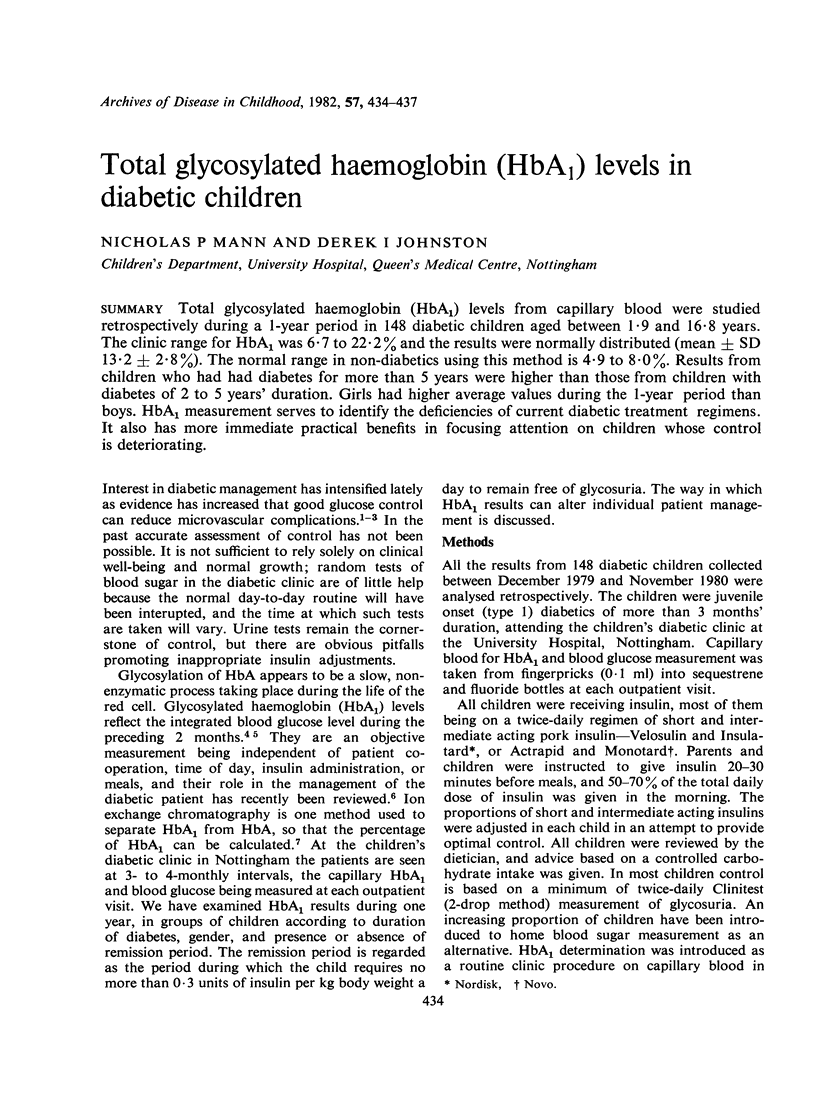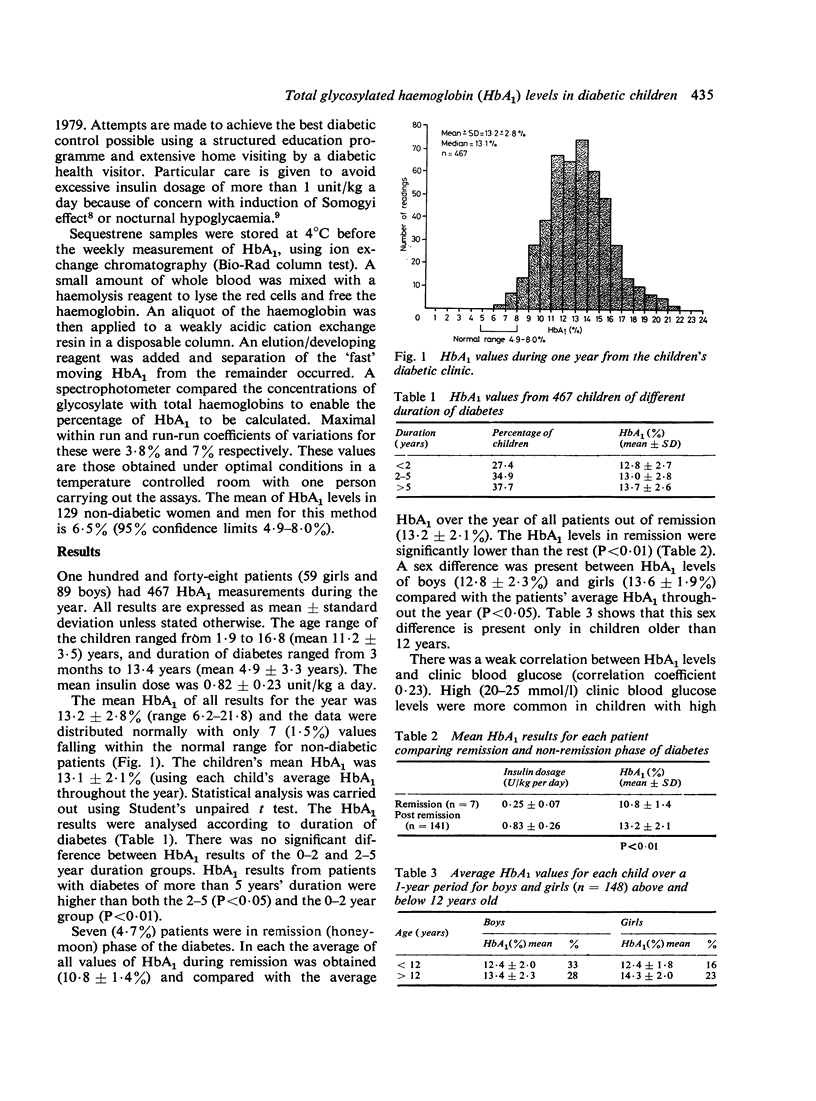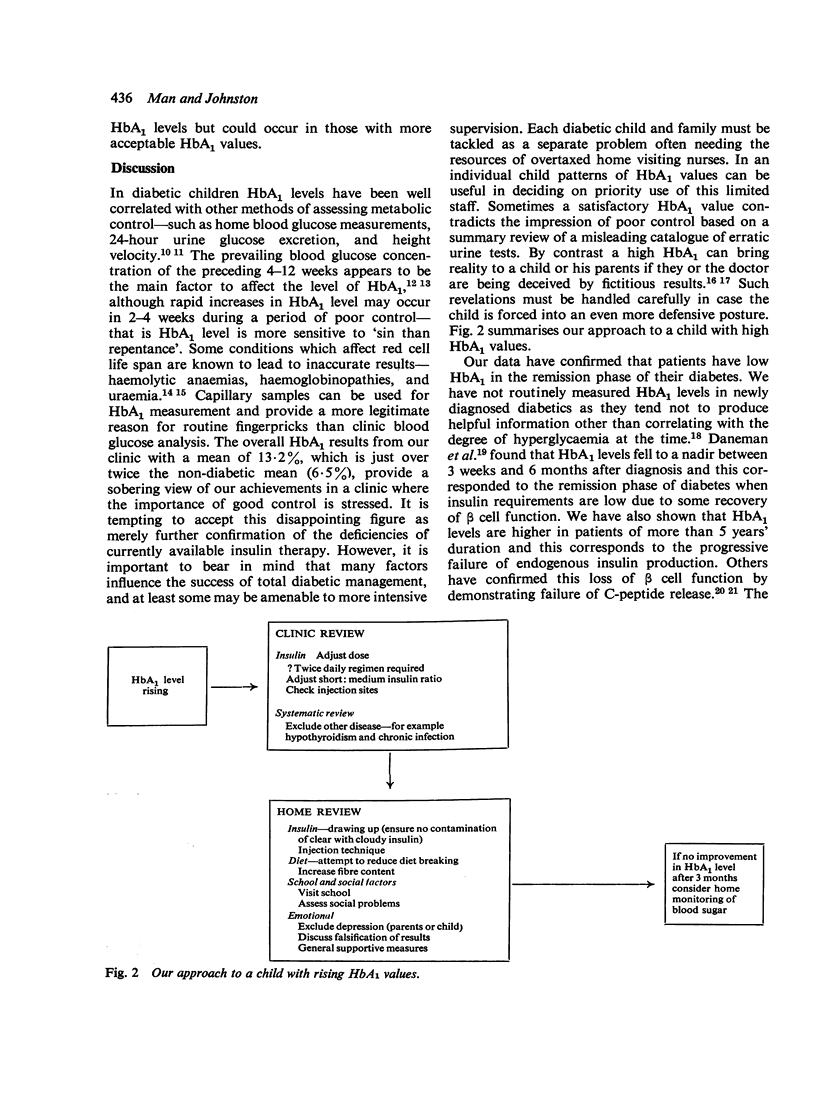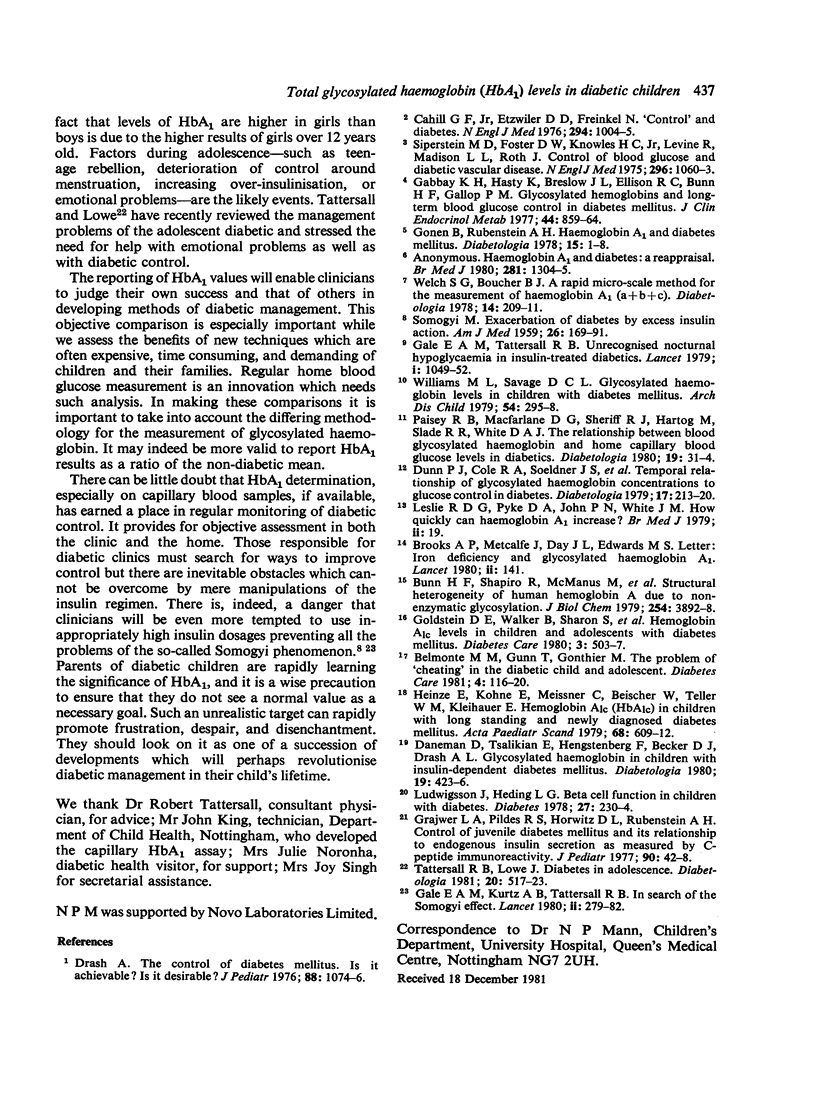Abstract
Total glycosylated haemoglobin (HbA1) levels from capillary blood were studied retrospectively during a 1-year period in 148 diabetic children aged between 1.9 and 16.8 years. The clinic range for HbA1 was 6.7 to 22.2% and the results were normally distributed (mean +/- SD 13.2 +/- 2.8%). The normal range in non-diabetics using this method is 4.9 to 8.0%. Results from children who had had diabetes for more than 5 years were higher than those from children with diabetes of 2 to 5 years' duration. Girls had higher average values during the 1-year period than boys. HbA1 measurement serves to identify the deficiencies of current diabetic treatment regimens. It also has more immediate practical benefits in focusing attention on children whose control is deteriorating.
Full text
PDF



Selected References
These references are in PubMed. This may not be the complete list of references from this article.
- Belmonte M. M., Gunn T., Gonthier M. The problem of "cheating" in the diabetic child and adolescent. Diabetes Care. 1981 Jan-Feb;4(1):116–120. doi: 10.2337/diacare.4.1.116. [DOI] [PubMed] [Google Scholar]
- Brooks A. P., Metcalfe J., Day J. L., Edwards M. S. Iron deficiency and glycosylated haemoglobin A. Lancet. 1980 Jul 19;2(8186):141–141. doi: 10.1016/s0140-6736(80)90019-7. [DOI] [PubMed] [Google Scholar]
- Bunn H. F., Shapiro R., McManus M., Garrick L., McDonald M. J., Gallop P. M., Gabbay K. H. Structural heterogeneity of human hemoglobin A due to nonenzymatic glycosylation. J Biol Chem. 1979 May 25;254(10):3892–3898. [PubMed] [Google Scholar]
- Cahill G. F., Jr, Etzwiler L. D., Freinkel N. Editorial: "Control" and diabetes. N Engl J Med. 1976 Apr 29;294(18):1004–1005. doi: 10.1056/NEJM197604292941811. [DOI] [PubMed] [Google Scholar]
- Daneman D., Tsalikian E., Hengstenberg F., Becker D. J., Drash A. L. Glycosylated haemoglobin in children with insulin-dependent diabetes mellitus. Diabetologia. 1980 Nov;19(5):423–426. doi: 10.1007/BF00281820. [DOI] [PubMed] [Google Scholar]
- Drash A. The control of diabetes mellitus: is it achievable? Is it desirable? J Pediatr. 1976 Jun;88(6):1074–1076. doi: 10.1016/s0022-3476(76)81104-3. [DOI] [PubMed] [Google Scholar]
- Dunn P. J., Cole R. A., Soeldner J. S., Gleason R. E., Kwa E., Firoozabadi H., Younger D., Graham C. A. Temporal relationship of glycosylated haemoglobin concentrations to glucose control in diabetics. Diabetologia. 1979 Oct;17(4):213–220. doi: 10.1007/BF01235857. [DOI] [PubMed] [Google Scholar]
- Gabbay K. H., Hasty K., Breslow J. L., Ellison R. C., Bunn H. F., Gallop P. M. Glycosylated hemoglobins and long-term blood glucose control in diabetes mellitus. J Clin Endocrinol Metab. 1977 May;44(5):859–864. doi: 10.1210/jcem-44-5-859. [DOI] [PubMed] [Google Scholar]
- Gale E. A., Kurtz A. B., Tattersall R. B. In search of the Somogyi effect. Lancet. 1980 Aug 9;2(8189):279–282. doi: 10.1016/s0140-6736(80)90233-0. [DOI] [PubMed] [Google Scholar]
- Gale E. A., Tattersall R. B. Unrecognised nocturnal hypoglycaemia in insulin-treated diabetics. Lancet. 1979 May 19;1(8125):1049–1052. doi: 10.1016/s0140-6736(79)92950-7. [DOI] [PubMed] [Google Scholar]
- Goldstein D. E., Walker B., Rawlings S. S., Hess R. L., England J. D., Peth S. B., Hewett J. E. Hemoglobin A1c levels in children and adolescents with diabetes mellitus. Diabetes Care. 1980 Jul-Aug;3(4):503–507. doi: 10.2337/diacare.3.4.503. [DOI] [PubMed] [Google Scholar]
- Grajwer L. A., Pildes R. S., Horwitz D. L., Rubenstein A. H. Control of juvenile diabetes mellitus and its relationship to endogenous insulin secretion as measured by C-peptide immunoreactivity. J Pediatr. 1977 Jan;90(1):42–48. doi: 10.1016/s0022-3476(77)80762-2. [DOI] [PubMed] [Google Scholar]
- Heinze E., Kohne E., Meissner C., Beischer W., Teller W. M., Kleihauer E. Hemoglobin A1c (HbA1c) in children with long standing and newly diagnosed diabetes mellitus. Acta Paediatr Scand. 1979 Jul;68(4):609–612. doi: 10.1111/j.1651-2227.1979.tb05064.x. [DOI] [PubMed] [Google Scholar]
- Leslie R. D., Pyke D. A., John P. N., White J. M. How quickly can haemoglobin A1 increase? Br Med J. 1979 Jul 7;2(6181):19–19. doi: 10.1136/bmj.2.6181.19. [DOI] [PMC free article] [PubMed] [Google Scholar]
- Ludvigsson J., Heding L. G. beta-cell function in children with diabetes. Diabetes. 1978;27 (Suppl 1):230–234. doi: 10.2337/diab.27.1.s230. [DOI] [PubMed] [Google Scholar]
- Paisey R. B., Macfarlane D. G., Sherriff R. J., Hartog M., Slade R. R., White D. A. The relationship between blood glycosylated haemoglobin and home capillary blood glucose levels in diabetics. Diabetologia. 1980 Jul;19(1):31–34. doi: 10.1007/BF00258307. [DOI] [PubMed] [Google Scholar]
- SOMOGYI M. Exacerbation of diabetes by excess insulin action. Am J Med. 1959 Feb;26(2):169–191. doi: 10.1016/0002-9343(59)90307-9. [DOI] [PubMed] [Google Scholar]
- Siperstein M. D., Foster D. W., Knowles H. C., Levine R., Madison L. L., Roth J. Control of blood glucose and diabetic vascular disease. N Engl J Med. 1977 May 5;296(18):1060–1063. doi: 10.1056/NEJM197705052961812. [DOI] [PubMed] [Google Scholar]
- Tattersall R. B., Lowe J. Diabetes in adolescence. Diabetologia. 1981 May;20(5):517–523. doi: 10.1007/BF00252758. [DOI] [PubMed] [Google Scholar]
- Welch S. G., Boucher B. J. A rapid micro-scale method for the measurement of Haemoglobin A1(a+b+c). Diabetologia. 1978 Mar;14(3):209–211. doi: 10.1007/BF00429782. [DOI] [PubMed] [Google Scholar]
- Williams M. L., Savage D. C. Glycosylated haemoglobin levels in children with diabetes mellitus. Arch Dis Child. 1979 Apr;54(4):295–298. doi: 10.1136/adc.54.4.295. [DOI] [PMC free article] [PubMed] [Google Scholar]


